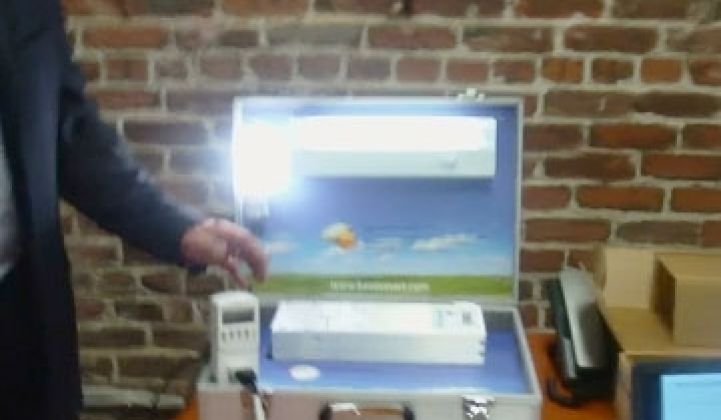Compression algorithms have made MP3 and online video practical. Cavet Technologies says the same principles apply in energy efficient lighting.
The company has created a shoebox-size device that essentially cuts the power consumed in buildings or public spaces like parking garages by cutting off power to the fluorescent lights inside them for strategically selected nanoseconds.
In principle, the software functions in a similar way to the compression algorithms that cut down the size of music files or digital photos: bits get eliminated in a way that does not destroy the overall integrity of the whole. Cavet hopes to obtain UL certification soon.
"We are tricking the ballast [the brick inside of lamps that controls power flow] into thinking it is getting full power," said CEO Albert Behr. "We are reducing the power going into the lighting circuits."
So what, you ask? Most fluorescent light fixtures -- which account for 85 percent of commercial lighting in the U.S. -- typically are not dimmable. The bulbs either burn at full power or are dark. Adura Technologies, Lumetric (formerly HID Laboratories) and Lumenergi in recent years have come up with dimmable ballasts for traditional bulbs that connect to building management systems. But in each case, building owners need to swap out the existing ballasts, a component in each individual light fixture, for new ones.
Cavet claims building owners will not have to swap out ballasts, thereby cutting the installation costs. The only hardware that needs to be installed is the LumiSmart controller, the shoebox-looking thing that costs $2,000. A single LumiSmart can control 150 light fixtures, the company says.
In Ontario, where peak power costs less than 10 cents, payback on the system can occur in under two years, Behr said. In the Bay Area, where average power costs more than 10 cents, payback can occur in a year.
In some early tests, users have turned down their lights by up to 35 percent without complaints about dimness. Utilities and some state regulators have talked about including the product in energy efficiency programs. Schools and owners of older buildings will also likely become interested, according to Behr: because little retrofitting is involved, swapping out lights won't raise asbestos concerns.
When it comes to building management, lighting is the final frontier. Only a small fraction -- one to 15 percent, depending on who you ask -- of the lighting systems in commercial buildings are connected to a network. Lighting consumes 22 percent of the electricity in the U.S., with a good portion of that power going to provide illumination to empty offices, vacant parking lots and abandoned conference rooms.
"It [the grid] is the biggest goddamned network in the world," Behr enthused. (Behr is the one wearing glasses in the video. The other person is David Berg, EVP of engineering.)
Lighting networking companies can also exploit human biology. People get used to slightly lower than normal levels of light because their irises adjust to it. Thus, lights are easier to turn down than thermostats without risking complaints even though technically lights represent a greater challenge.
Cavet's controller is in some ways less and more sophisticated as the products from other vendors. When daylight streams in through office windows on an Adura network, the overhead lights can be programmed to dim independently and dynamically. (The other companies are also further along in selling the product commercially.)
Cavet does not include networking or dynamic, automated control yet. The lights are programmed centrally by building managers and turned to the same level. Networking, however, will come in later versions. Creating more of a manual device allows it to keep costs low and get to market quicker.
Once networking is added, it hopes to link up with demand service providers. Right now, companies like EnerNoc and CPower curb power mostly by turning down air conditioners or heaters. Lighting controls will give them another instrument in the orchestra.
Technically speaking, Cavet modifies the wave form of incoming power. It shuts off power delivery for brief nano-second scale periods at the top of the sine wave. Reserve electricity is stored in capacitors inside the device that guarantee continual flow. Thus, energy conservation is hidden from the ballast and light.
Behr and Berg further added that LumiSmart is somewhat easy to install. Electricians don't need to worry about the inner workings of the device. It just needs to be connected with a few wires between the circuit breaker and the first light fixture.
Cavet will sell it through distribution channels. It will also sell the device under its own name and allow other manufacturers to resell and rebrand it under their own names.
Does it actually work? Customer reviews of all of these products will determine winners and losers. Moreover, all of the fluorescent dimmer companies will have to contend with the outfits like Redwood Systems and Digital Lumens that make even more elaborate networks for LED lighting.
Still, it's an interesting twist in a market that bears watching.



